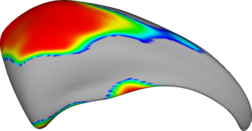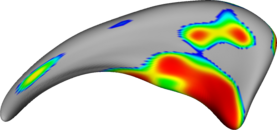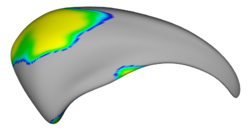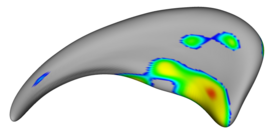Difference between revisions of "Projects:ShapeAnalysisOfCaudateAndCorpusCallosum"
From NAMIC Wiki
| Line 3: | Line 3: | ||
Back to [[NA-MIC_Collaborations|NA-MIC_Collaborations]], [[Algorithm:GATech|Georgia Tech Algorithms]], [[Algorithm:UNC|UNC Algorithms]] | Back to [[NA-MIC_Collaborations|NA-MIC_Collaborations]], [[Algorithm:GATech|Georgia Tech Algorithms]], [[Algorithm:UNC|UNC Algorithms]] | ||
| − | ''' | + | '''Objectives''' |
To improve shape analysis of the caudate and to parcellate the corpus callosum based on function. | To improve shape analysis of the caudate and to parcellate the corpus callosum based on function. | ||
| Line 13: | Line 13: | ||
* Harvard applied the UNC shape analysis software to a new dataset of manually segmented caudates of females with and without schizotypal personality disorder. The results confirmed previous findings in the male dataset. Statistically significant shape differences for the right caudate were found (see Fig 1). | * Harvard applied the UNC shape analysis software to a new dataset of manually segmented caudates of females with and without schizotypal personality disorder. The results confirmed previous findings in the male dataset. Statistically significant shape differences for the right caudate were found (see Fig 1). | ||
* A less stringent method to correct for multiple comparisons (false discovery rate; FDR) was implemented (UNC) and applied to the the male and female caudata datasets (see Fig 2). | * A less stringent method to correct for multiple comparisons (false discovery rate; FDR) was implemented (UNC) and applied to the the male and female caudata datasets (see Fig 2). | ||
| + | |||
| + | ''References'' | ||
'''Key Investigators''' | '''Key Investigators''' | ||
| Line 19: | Line 21: | ||
* UNC: Martin Styner, Isabelle Corouge, Guido Gerig | * UNC: Martin Styner, Isabelle Corouge, Guido Gerig | ||
* Georgia Tech: Delphine Nain, Allen Tannenbaum | * Georgia Tech: Delphine Nain, Allen Tannenbaum | ||
| − | |||
| − | |||
{| | {| | ||
Revision as of 13:49, 4 September 2007
Home < Projects:ShapeAnalysisOfCaudateAndCorpusCallosumShape Analysis for the caudate and corpus callosum data
Back to NA-MIC_Collaborations, Georgia Tech Algorithms, UNC Algorithms
Objectives
To improve shape analysis of the caudate and to parcellate the corpus callosum based on function.
Progress
- UNC applied shape analysis pipeline to a dataset of manually segmented caudates of males with and without schizoptypal personality disorders. Differences were found mainly on the right caudates. No differences were found for regional parcellations of the corpus callosum.
- The open source shape analysis pipeline was transfered and installed at Harvard PNL.
- Harvard applied the UNC shape analysis software to a new dataset of manually segmented caudates of females with and without schizotypal personality disorder. The results confirmed previous findings in the male dataset. Statistically significant shape differences for the right caudate were found (see Fig 1).
- A less stringent method to correct for multiple comparisons (false discovery rate; FDR) was implemented (UNC) and applied to the the male and female caudata datasets (see Fig 2).
References
Key Investigators
- BWH: Sylvain Bouix, Marek Kubicki, James Levitt, Marc Niethammer, Martha Shenton
- UNC: Martin Styner, Isabelle Corouge, Guido Gerig
- Georgia Tech: Delphine Nain, Allen Tannenbaum
Links





